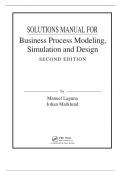SOLUTIONS MANUAL FOR
Business Process Modeling,
Simulation and Design
S E C OND EDITION
by
Manuel Laguna
Johan Marklund
A CHAPMAN & HALL BOOK
, SOLUTIONS MANUAL FOR
Business Process Modeling,
Simulation and Design
S E C OND EDITION
by
Manuel Laguna
Johan Marklund
Boca Raton London New York
CRC Press is an imprint of the
Taylor & Francis Group, an informa business
A CHAPMAN & HALL BOOK
,Chapter 1:
1: Solutions to Exercises
Exercise 1
a)
Category Activities
Value adding 1, 4, (10)
Business value adding 8
Non-value adding 2, 3, 5, 6, 7, 9, 10
Activity 10 could be seen as value adding since getting the order to the supplier is something
the customer probably is willing to pay for. However, one could argue whether mailing it is
really value adding.
Note, the above assumes that a requisition process is needed, but is it necessarily so?
b) For the current requisition process the customers are the production people making the
request.
c) The customer wants a quick handling of the requisition and ultimately a fast replenishment of
goods.
A relevant measure of performance is then the ratio between the value adding activity time
and the total process time.
d) Value adding time = 10+18 = 28 minutes
Total process time = 10+720+75+18+75+720+45+12+90+720 = 2485 minutes
Value added ratio = 28/2485 ≈ 1.1 %
Not impressive performance of the current requisition process!
e) Looking for escape goats and people to blame is never constructive. To investigate/analyze
why the process is inefficient is on the other hand a sound approach.
Chapter 1: Solutions to Exercises P age |1
, Exercise 2
Alternative
a) Al ternative 1
Assuming that it is not possible to store the received goods at the final destination and that
direct just in time deliveries are not possible the following classification is plausible.
Category Activities
Value adding 8, 9, 10, 12, 13, 14
Business value adding 2, 11
Non-value adding 1, 3, 4, 5, 6, 7
Alternative 2
Questioning the relevance or need for intermediate storage at the satellite storage, the
following categorization makes sense. The only value adding activities are those that are
directly related to getting the goods to the right destination.
Category Activities
Value adding 13, 14
Business value adding 2, 11
Non-value adding 1, 3, 4, 5, 6, 7, 8, 9, 10, 12,
b) For the current receiving-and-delivery process the customers are the production people at the
different manufacturing facilities waiting for the received goods to be delivered.
c) The customer wants a quick cost efficient handling and timely delivery of the goods.
A relevant measure of performance is then the ratio between the value adding activity time
and the total process time. A quick handling implies shorter replenishment lead-times and
lower costs both in personnel and warehouse space as well as for capital tied up in inventory.
d) Alternative 1
Value adding time = 20+10+320+10+15+10 = 385 minutes
Total process time = 120+3+10+1440+10+60+10+20+10+320+2+10+15+10= 2040 minutes
Value added ratio = 385/2040 ≈ 18.9 %
Alternative 2
Value adding time = 15+10 = 25 minutes
Total process time = 120+3+10+1440+10+60+10+20+10+320+2+10+15+10= 2040 minutes
Value added ratio = 25/2040 ≈ 1.2 %
The performance is hardly impressive for either of the two alternatives, with or without the
storage requirement.
e) The instructions are straightforward and represent a reasonable first step. However,
eventually we need to have some understanding of the variability in the system, not least to
understand whether storage is necessary or not, and if it is how much inventory should we
Chapter 1: Solutions to Exercises P age |2




